railroad
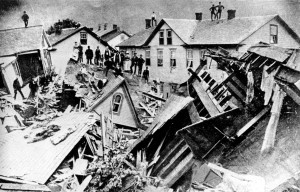 Over the years, man has tried many ways to harness water. Water is a necessity to life, and without it, all things would die off. Some projects worked out better than others, and some simply needed to be replaced sooner than they were in order to prevent disaster. A good example of that is the earthen dam. An earthen dam is a dam that is built out of rocks and dirt, instead of steel and concrete. Of course, when dams were first built, earthen dams were the only way to go, but after so many failed, a new type of dam had to be designed, in order to save lives. One such failure was the earthen dam built in 1840 on the Little Conemaugh River, fourteen miles upstream from Johnstown, Pennsylvania. Johnstown is sixty miles east of Pittsburgh, in a valley near the Allegheny, Little Conemaugh, and Stony Creek Rivers. The area lies in a floodplain that has had frequent disasters. This time would prove to be one of them. At nine hundred by seventy two feet, this dam was the largest earthen dam in the United States, creating the largest man-made lake at that time…Lake Conemaugh. At a time when here were no railroads in the area for transporting goods, the dam and its extensive canal system was the only way to transport goods to the people, but it became obsolete as the railroads replaced the canal as a means of transporting goods. The canal system was left to become a victim of the elements, and with its neglect, also came the neglect of the dam. In reality, people just didn’t really think anything would happen, and they most likely looked at the dam as just a part of the landscape.
Over the years, man has tried many ways to harness water. Water is a necessity to life, and without it, all things would die off. Some projects worked out better than others, and some simply needed to be replaced sooner than they were in order to prevent disaster. A good example of that is the earthen dam. An earthen dam is a dam that is built out of rocks and dirt, instead of steel and concrete. Of course, when dams were first built, earthen dams were the only way to go, but after so many failed, a new type of dam had to be designed, in order to save lives. One such failure was the earthen dam built in 1840 on the Little Conemaugh River, fourteen miles upstream from Johnstown, Pennsylvania. Johnstown is sixty miles east of Pittsburgh, in a valley near the Allegheny, Little Conemaugh, and Stony Creek Rivers. The area lies in a floodplain that has had frequent disasters. This time would prove to be one of them. At nine hundred by seventy two feet, this dam was the largest earthen dam in the United States, creating the largest man-made lake at that time…Lake Conemaugh. At a time when here were no railroads in the area for transporting goods, the dam and its extensive canal system was the only way to transport goods to the people, but it became obsolete as the railroads replaced the canal as a means of transporting goods. The canal system was left to become a victim of the elements, and with its neglect, also came the neglect of the dam. In reality, people just didn’t really think anything would happen, and they most likely looked at the dam as just a part of the landscape.
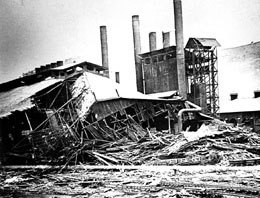
By 1889, Johnstown had grown to a population of 30,000 people, many of whom worked in the steel industry…ironically. On May 30, 1889, it began to rain, and continued steadily all day. No one really gave any thought the potential harm so much rain could bring to the nearly sixty year old earthen dam. The dam had a spillway, and so everything seemed safe, but the spillway became clogged with debris, that could not be dislodged. On May 31, 1889, an engineer at the dam saw the warning signs, but the only way to notify anyone was to ride his horse into the village of South Fork to warn the people…a ride that took an eternity in the face of the impending disaster. Nevertheless, it should have been enough time, but the telegraph lines were down, and no warning ever reached Johnstown. At 3:10pm, the dam collapsed with a roar that could be heard for miles. The water, moving at 40 miles per hour barreled down on the towns in it’s path, wiping out everything that got in its way. At Johnstown, 2,200 people lost their lives that day, including one Thomas Knox and his wife. Thomas, like a large number of the flood victims was never found. While I’m not sure that Thomas Knox is related to my husband, Bob Schulenberg’s family, it is quite likely that he is, as there are a number of Thomas Knox’s in the family…though none that I have found so far that died in the Johnstown Flood.
The people in the path of the raging flood waters, were tossed around, along with all that debris, including thirty three train engines that were pulled into the flood waters. I’m sure that for many, death did not come 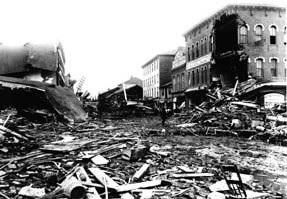 from drowning, but rather from blunt force trauma. Nevertheless, some people did manage to climb atop the debris, only to be burned alive when much of the debris caught fire, when it was caught in a bridge downstreem and burst into flames. There was a report of a baby that survived on the floor of a house that floated 75 miles downstream, but that was something that was not confirmed. It was during the Johnstown flood, that the American Red Cross handled its first major relief effort. Clara Barton arrived five days after the flood to lead the relief. In the end, it took five years to rebuild Johnstown, which went through disastrous floods in 1936 and 1977. I have to wonder if they should just move the town, but with no major floods since 1977, it’s hard to say.
from drowning, but rather from blunt force trauma. Nevertheless, some people did manage to climb atop the debris, only to be burned alive when much of the debris caught fire, when it was caught in a bridge downstreem and burst into flames. There was a report of a baby that survived on the floor of a house that floated 75 miles downstream, but that was something that was not confirmed. It was during the Johnstown flood, that the American Red Cross handled its first major relief effort. Clara Barton arrived five days after the flood to lead the relief. In the end, it took five years to rebuild Johnstown, which went through disastrous floods in 1936 and 1977. I have to wonder if they should just move the town, but with no major floods since 1977, it’s hard to say.
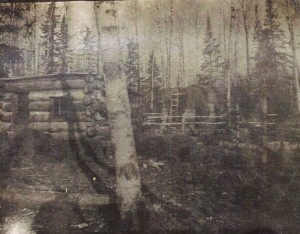 For a time, my grandfather, Allen Luther Spencer, worked in the lumber business. It started when he and my grandmother’s brother, Albert Schumacher, decided to go trapping in northern Minnesota. That venture didn’t go very well, and they just about froze to death. It was at that time that they decided to go into the lumber business. Being a lumberjack is no easy job, and was probably much more dangerous in my grandfather’s day, than it is now. Back then, lumberjacks, as they were called did everything from chopping down the trees, to cutting them with a saw, climbing up in the tree to get to the top. You name it, if it pertained to logging, they did it. They called it harvesting, and it begins with the lumberjack. The term lumberjack is not a term that is used much
For a time, my grandfather, Allen Luther Spencer, worked in the lumber business. It started when he and my grandmother’s brother, Albert Schumacher, decided to go trapping in northern Minnesota. That venture didn’t go very well, and they just about froze to death. It was at that time that they decided to go into the lumber business. Being a lumberjack is no easy job, and was probably much more dangerous in my grandfather’s day, than it is now. Back then, lumberjacks, as they were called did everything from chopping down the trees, to cutting them with a saw, climbing up in the tree to get to the top. You name it, if it pertained to logging, they did it. They called it harvesting, and it begins with the lumberjack. The term lumberjack is not a term that is used much 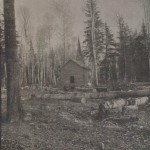 these days, because the modern way of harvesting is very different. Lumberjacks were pretty much a pre-1945 term. Hand tools were the harvest tools used, because there were no machines like what we have now.
these days, because the modern way of harvesting is very different. Lumberjacks were pretty much a pre-1945 term. Hand tools were the harvest tools used, because there were no machines like what we have now.
The actual work of a lumberjack was difficult, dangerous, intermittent, low-paying, and primitive in living conditions, but the men built a traditional culture that celebrated strength, masculinity, confrontation with danger, and resistance to modernization. These days, there are a few people who actually celebrate the lumberjacking trade. Mostly it involves competitions, but just by watching, you can see that being a lumberjack was not a job for a weakling.
Lumberjacks, and their families, usually lived in a lumber camp, moving from site to site and the job moved. I 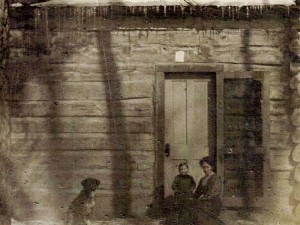 know that my grandmother and my Aunt Laura spent time in the lumber camps. From what I’ve been told, the houses were little more that a log tent. They didn’t stay very warm, because there were gaps in the walls, and my guess is that they could only use a certain amount of wood a day, so it didn’t eat into the profits. I suppose that the owner of the logging operation made a good profit, but that doesn’t mean that the people who worked for them made a great deal of money, because they really didn’t. Being a lumberjack was really a far from glamorous occupation, and like most really physical jobs, not one that a man can do for too many years. Before long, my grandfather, like most lumberjacks, moved on to other jobs, in grandpa’s case the railroad.
know that my grandmother and my Aunt Laura spent time in the lumber camps. From what I’ve been told, the houses were little more that a log tent. They didn’t stay very warm, because there were gaps in the walls, and my guess is that they could only use a certain amount of wood a day, so it didn’t eat into the profits. I suppose that the owner of the logging operation made a good profit, but that doesn’t mean that the people who worked for them made a great deal of money, because they really didn’t. Being a lumberjack was really a far from glamorous occupation, and like most really physical jobs, not one that a man can do for too many years. Before long, my grandfather, like most lumberjacks, moved on to other jobs, in grandpa’s case the railroad.
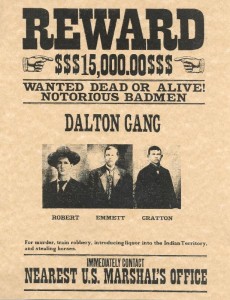
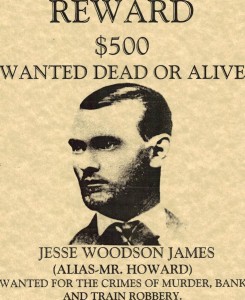 As the railroad spread across this land, and payrolls began coming in by way of the railroad, a new breed of criminal showed up on the scene…the train robbers. At first, the train robbers got away with it, because no one had really given much thought to the possibility of such a thing happening. Gangs like Jesse James…who was best known as a bank robber, but was also one of the early train robbers, Butch Cassidy and the Wild Bunch, the Dalton Gang, and the Reno Gang terrorized the railways, stealing the payrolls of crews working on building the railroads and towns in the west.
As the railroad spread across this land, and payrolls began coming in by way of the railroad, a new breed of criminal showed up on the scene…the train robbers. At first, the train robbers got away with it, because no one had really given much thought to the possibility of such a thing happening. Gangs like Jesse James…who was best known as a bank robber, but was also one of the early train robbers, Butch Cassidy and the Wild Bunch, the Dalton Gang, and the Reno Gang terrorized the railways, stealing the payrolls of crews working on building the railroads and towns in the west.
With the advent of train robberies came a need for a solution. Enter the train police. At first the railroads would arrange for a posse to go after the robbers, but eventually they realized that the posse was too little too late. They had to take affirmative action. So they put the police on the train with the money. I’m sure that more violence came from that action, but the robbers probably didn’t get away with it as often as they had been.
I think that in many ways, we have almost romanticized the train robbers, but in reality, they were like any other criminal. They would kill for the money they were after. The police were under as much pressure as the police these days. You can’t face a gun as a regular part of your job and not have some degree of fear for your life. These men were the law, and they were pretty much on their own. They couldn’t call in the state police, or the police from the next town over. Those were too far away…especially with the distances the trains traveled. The railroad police were the only thing standing between the robbers and the money.
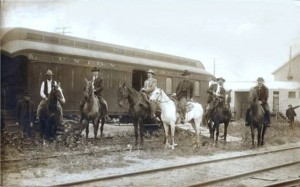
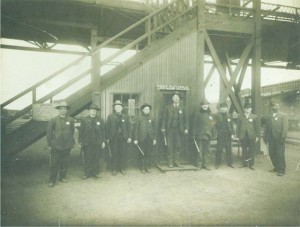 Theirs was an important job too. Every time the train was robbed, peoples lives were affected. Without the payroll money, the workers couldn’t support their families, and that caused more problems. The workers were angry and then desperate. I don’t think police work would be for me, but I have to wonder if police work was harder back in the old west, or now, with the terrorism and gang issues…or if police work is police work, no matter what era it is.
Theirs was an important job too. Every time the train was robbed, peoples lives were affected. Without the payroll money, the workers couldn’t support their families, and that caused more problems. The workers were angry and then desperate. I don’t think police work would be for me, but I have to wonder if police work was harder back in the old west, or now, with the terrorism and gang issues…or if police work is police work, no matter what era it is.
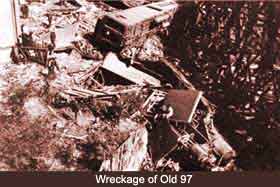 People always seem to be in a hurry. We encounter cars that fly past us trying to get to their destination on time, when they really didn’t allow enough time for the trip. We are all guilty of running late, and even of speeding to make it on time, and as we all know, sometimes our habit of running late and being in such a hurry, can have bad consequences. Sometimes the consequences of running late can be devastating. Such was the case with Old 97, a mail train for Southern Railways. While it’s number was simply number 97, and it was officially known as the Fast Mail, its nickname was Old 97. The train ran from Washington DC to Atlanta, Georgia. On September 27, 1903 it was en route from Monroe, Virginia, to Spencer, North Carolina when disaster struck…or rather was forced upon the ill fated train.
People always seem to be in a hurry. We encounter cars that fly past us trying to get to their destination on time, when they really didn’t allow enough time for the trip. We are all guilty of running late, and even of speeding to make it on time, and as we all know, sometimes our habit of running late and being in such a hurry, can have bad consequences. Sometimes the consequences of running late can be devastating. Such was the case with Old 97, a mail train for Southern Railways. While it’s number was simply number 97, and it was officially known as the Fast Mail, its nickname was Old 97. The train ran from Washington DC to Atlanta, Georgia. On September 27, 1903 it was en route from Monroe, Virginia, to Spencer, North Carolina when disaster struck…or rather was forced upon the ill fated train.
When the train arrived in Monroe, it switched train crews and when it left Monroe there were 17 people on board. The train personnel included Joseph A Broady who was the engineer, nicknamed “Steve” by his friends, John Blair was the conductor, A C Clapp was the fireman, John Hodge was a student fireman, and James Robert Moody was the flagman. Also aboard were mail clerks, including J L Thompson, Scott Chambers, Daniel Flory, Paul Argenbright, Lewis Spies, Frank Brooks, Percival Indermauer, Charles Reames, Jennings Dunlap, Napoleon Maupin, J H Thompson, and W R Pinckney, who was an express messenger.
As they left Monroe, Old 97’s engineer, 33 year old Broady found himself running late, and in a hurry to get the train back on schedule. When the train pulled into Lynchburg, VA, Wentworth Armistead, who was a safe locker boarded the train so at that time there were 18 men aboard. The train consisted of four cars, and Broady was operating the train at high speed in order to stay on schedule and arrive at Spencer on time. You see, Fast Mail had a reputation for never being late…and a contract that included a fine if they were. Old 97 was behind schedule when it left Washington, DC and was one hour late when it arrived in Monroe, Virginia. All that was unacceptable, but Southern Railways and Engineer Broady were about to discover two things. The first is that 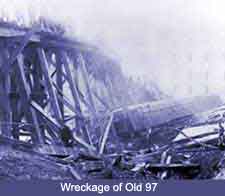 it is always best to stay on schedule, when a schedule is an important part of your job. The second is that there are far worse things than being late.
it is always best to stay on schedule, when a schedule is an important part of your job. The second is that there are far worse things than being late.
By the time Old 97 reached the Stillhouse Trestle near Danville, Virginia, Broady realized, with a horrible sense of dread and impending doom, that he did not have enough air pressure to slow the train for Stillhouse’s upcoming curved trestle. He tried, in vain to slow the train down by reversing the engine to lock the wheels, but Old 97 vaulted off the trestle, and 11 people were killed. Nine men of the eleven who died, were killed instantly. Seven men were injured. Among the deceased were the engineer Broady, conductor Blair, and flagman Moody. The bodies of both firemen were recovered, but they were mangled so badly they were unrecognizable. There were several survivors to the wreck who believed they survived because they jumped from the train just before the fatal plunge. Among the three survivors was an individual named J Harris Thompson of Lexington. Harris was a mail-clerk who served on the Southern Railroad. He later retired on May 1, 1941. W R Pinckney, the express messenger who also survived went home, located in Charlotte, North Carolina, and immediately resigned after the experience. Two other survivors included Jennings J Dunlap, and M C Maupin. These two men did not resign and continued their work, but started in new departments. Dunlap went to work on a train that ran between Washington and Charlotte, while Maupin worked at the Charlotte union station. The horrible pictures of the aftermath of the crash taken from above the scene ran in newspapers across the country.
At Monroe, Broady was instructed to get the Fast Mail to Spencer, 166 miles away…on time. The scheduled running time from Monroe to Spencer was four hours and fifteen minutes at an average speed of approximately 39 miles per hour. In order to make up the one hour delay, the train’s average speed would have to be at least 51 miles per hour. Broady was ordered to maintain speed through Franklin Junction, an intermediate stop normally made during the run. This was a time when train wrecks were not uncommon, but the day after the wreck, Southern Railway’s Vice President stated that “The train consisted of two postal cars, one express and one baggage car for the storage of mail… Eyewitnesses said the train was approaching the trestle at speeds of 30 to 35 miles an hour.” The Southern Railway placed blame for the wreck on engineer Broady, denying that he 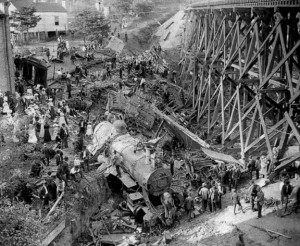 had been ordered to run as fast as possible to maintain the schedule. The railroad also claimed he descended the grade leading to Stillhouse Trestle at a speed of more than 70 miles per hour. Several eyewitnesses to the wreck, however, stated that the speed was probably around 50 miles per hour. In all likelihood, the railroad was at least partially to blame, as they had a lucrative contract with the US Post Office to haul mail…a contract that did include a penalty clause for each minute the train was late into Spencer. It is probably safe to conclude that the engineers piloting the Fast Mail were always under pressure to stay on time so the railroad would not be penalized for late mail delivery. And being under pressure can be deadly.
had been ordered to run as fast as possible to maintain the schedule. The railroad also claimed he descended the grade leading to Stillhouse Trestle at a speed of more than 70 miles per hour. Several eyewitnesses to the wreck, however, stated that the speed was probably around 50 miles per hour. In all likelihood, the railroad was at least partially to blame, as they had a lucrative contract with the US Post Office to haul mail…a contract that did include a penalty clause for each minute the train was late into Spencer. It is probably safe to conclude that the engineers piloting the Fast Mail were always under pressure to stay on time so the railroad would not be penalized for late mail delivery. And being under pressure can be deadly.
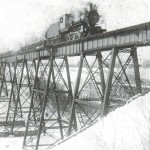 In their early years, the railroads were quite powerful companies, and with good reason. The railroad reduced travel time across the United States from days or months, to hours, in many cases. They brought supplies, payroll, and people from back east to the west quickly. The railroad did not come without some confusion, however. Even as late as the 1880s, most United States towns had their own system for keeping track of time, based on where the sun was at high noon. I had never given much thought to this, but I suppose it could have been a big mess, since the train’s arrival would be very mixed up, and the end result would be that the train might be scheduled to arrive in several places at once.
In their early years, the railroads were quite powerful companies, and with good reason. The railroad reduced travel time across the United States from days or months, to hours, in many cases. They brought supplies, payroll, and people from back east to the west quickly. The railroad did not come without some confusion, however. Even as late as the 1880s, most United States towns had their own system for keeping track of time, based on where the sun was at high noon. I had never given much thought to this, but I suppose it could have been a big mess, since the train’s arrival would be very mixed up, and the end result would be that the train might be scheduled to arrive in several places at once.
Because the railroads were quite powerful, they took it upon themselves to make a monumental change that would affect the entire nation, and Canada too. At exactly noon on this day in 1883, American and Canadian railroads broke the continent into four sections, and began using a system of time zones that we still use to this day, with very few changes made to it over the years. I’m sure there were people who did not like the new system much, but most people quickly embraced it, because their lives depended on the railroad in one way or another. The root of the problem they had was that they moved passengers and freight over the thousands of miles the line covered. With the varying times in towns along the route, the train 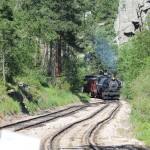 ended up with dozens of different departure and arrival times. No one really knew when the train would arrive…except possibly the engineer. I’m sure that caused chaos in the train stations…especially in the bigger cities. These days, we have to be at the airport two hours early for flights, because of screening, so imagine that kind of a scenario in the small train stations of the old west. This scheduling nightmare had to be stopped, and time zones were the only logical way to do it.
ended up with dozens of different departure and arrival times. No one really knew when the train would arrive…except possibly the engineer. I’m sure that caused chaos in the train stations…especially in the bigger cities. These days, we have to be at the airport two hours early for flights, because of screening, so imagine that kind of a scenario in the small train stations of the old west. This scheduling nightmare had to be stopped, and time zones were the only logical way to do it.
With the use of time zones, rail transportation became far more efficient. The thing that seems rather odd, is that they didn’t go to the United States or Canadian governments to resolve the problem, and if the government at that time was as inefficient as our congress is right now, I can fully understand why they didn’t. Imaging waiting six years to make a decision concerning time and its vital role in rail travel. Something had to be done right away, and the railroad was just bold enough to do it. As it turned out, no one tried to stop them either. I suppose everyone could see just how logical their plan was, and no one complained. So, the railroad companies agreed to create four continental time zones, and that decision has changed the way we live to this day.
The lines they adopted to make those time zones were very close to the ones we have today. I’m sure that any changes are based on where towns began to fall along the zone lines. It wasn’t until as late as 1918 that Congress officially adopted the railroad time zones and put them under the Interstate Commerce Commission. 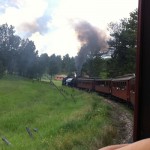 Just imagine, if you will, if the people and the railroad had waited for Congress to act on this matter. There would have been 35 more years of unorganized and frustrating railroad travel. Something that should have revolutionized travel, would have been relegated to the stone age again, because of Congress’ lack of action. Even after the system was implemented and people finally had an organized schedule, that was relatively accurate…because you can’t predict accidents or weather related delays very well, Congress sat on their hands, and I suppose they operated the government on government time instead. In this writer’s opinion, the time zones were a wonderful idea, and have benefitted this nation very well since 1883. My family has a long history of working on the railroad, and that is a fact that I am very proud of.
Just imagine, if you will, if the people and the railroad had waited for Congress to act on this matter. There would have been 35 more years of unorganized and frustrating railroad travel. Something that should have revolutionized travel, would have been relegated to the stone age again, because of Congress’ lack of action. Even after the system was implemented and people finally had an organized schedule, that was relatively accurate…because you can’t predict accidents or weather related delays very well, Congress sat on their hands, and I suppose they operated the government on government time instead. In this writer’s opinion, the time zones were a wonderful idea, and have benefitted this nation very well since 1883. My family has a long history of working on the railroad, and that is a fact that I am very proud of.
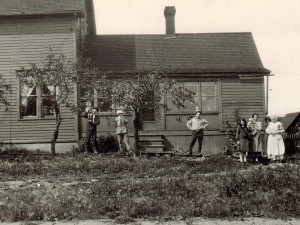 Through the years, people have taken in boarders to help make ends meet. These days, people might have a roommate to share the financial load when buying a house or renting an apartment, but that didn’t happen often in years gone by. When it became necessary to find a way to make ends meet, people took in boarders…usually people they didn’t know. They might be people who were working in the area, or in college towns, maybe students. For my grandmother, I think it must have been men working in the area. I’m sure she didn’t know the men prior to renting them a room, but they quickly became like family. She wanted to get a picture that included the boarders, and one of the men even held my Uncle Bill on his shoulder. Times were just different then, and most people were decent and trustworthy. There was, for the most part, a moral code that was followed.
Through the years, people have taken in boarders to help make ends meet. These days, people might have a roommate to share the financial load when buying a house or renting an apartment, but that didn’t happen often in years gone by. When it became necessary to find a way to make ends meet, people took in boarders…usually people they didn’t know. They might be people who were working in the area, or in college towns, maybe students. For my grandmother, I think it must have been men working in the area. I’m sure she didn’t know the men prior to renting them a room, but they quickly became like family. She wanted to get a picture that included the boarders, and one of the men even held my Uncle Bill on his shoulder. Times were just different then, and most people were decent and trustworthy. There was, for the most part, a moral code that was followed.
I’m sure the men helped out with things around the place while they lived at my grandmother’s home, and I’m also sure they ate some of their meals with the family. I also seriously doubt that the rent charged was very much, because in the 1930’s, times were hard and people couldn’t afford to pay very much. These men were grateful, I’m sure, for the opportunity to have a place to live, and a nice family to live with. Many of those men were far from home, trying to make a living for their families who were waiting for their return. It was quite a lonely way to support your family, but you did what you had to do.
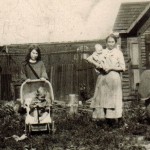
I’m not sure how long or how many times my grandmother had boarders living in her home, but I know she was a kindhearted woman who would have had a hard time thinking about some man sleeping in the freezing cold winter weather when her home had a spare room that he could have. And having a little help around the place wasn’t a bad thing either, because my grandfather worked on the railroad, and my dad and Uncle Bill were just little boys, so they couldn’t help much. The reasons that people take in boarders or roommates vary, but it usually boils down to need, either the need of the family to have an extra income, or the need of the boarder to have a place to live. It’s as simple as that.
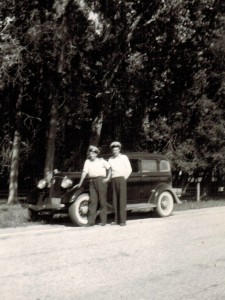 After spending some time in the early spring of 1940, working for the railroad in the car repair department, my uncle, William Malrose Spencer, decided the work was not for him. He quit the job that paid him 38¢ an hour…an amount that made every kid in Holyoke, Minnesota green with envy. With some of the money he had made, he purchased a 1934 Plymouth for which he paid $65.00. I’m sure that was a lot of money to pay for a car back then, but today, we would not get much of a car for $65.00. Nevertheless, in 1940, $65.00 bought my uncle a car that was only six years old, and that is truly amazing. No wonder the kids in town were envious of my Uncle Bill’s great job. At 18 years of age,
After spending some time in the early spring of 1940, working for the railroad in the car repair department, my uncle, William Malrose Spencer, decided the work was not for him. He quit the job that paid him 38¢ an hour…an amount that made every kid in Holyoke, Minnesota green with envy. With some of the money he had made, he purchased a 1934 Plymouth for which he paid $65.00. I’m sure that was a lot of money to pay for a car back then, but today, we would not get much of a car for $65.00. Nevertheless, in 1940, $65.00 bought my uncle a car that was only six years old, and that is truly amazing. No wonder the kids in town were envious of my Uncle Bill’s great job. At 18 years of age, 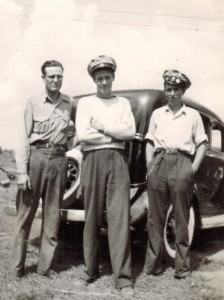 he must have seemed quite grown up.
he must have seemed quite grown up.
After leaving the railroad, Uncle Bill returned home in early June…just in time to make hay, which took most of the month of June. Toward the end of June, Uncle Bill decided to head out to North Dakota to work in the harvest fields out there. Although he was only 16 years of age, my dad, Allen Lewis Spencer and their friend, Bob Croft decided to go along. So, they loaded up in Uncle Bill’s 1934 Plymouth and headed out. Their plan was to work in different harvest ready fields along their way.
This all seems like an easy money scheme, until you think about the fact that this trip was made during the pre-combine years. At that time, the grain was cut with a binder and then hauled to the threshing machine, with horses and wagons. Of course, all this was 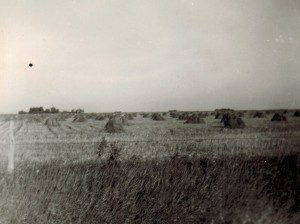 done in the heat of the day, and the men didn’t really wear tank tops and shorts back then. They simply sweated it out. The work was not easy either. There was a lot of bending, lifting, loading, and unloading. They worked liked dogs from sun up to sun down, but that was just the way things were done back then.
done in the heat of the day, and the men didn’t really wear tank tops and shorts back then. They simply sweated it out. The work was not easy either. There was a lot of bending, lifting, loading, and unloading. They worked liked dogs from sun up to sun down, but that was just the way things were done back then.
The guys spent the rest of that summer in the fields of North Dakota, before returning home when the harvest was done. Uncle Bill says that the trip was quite the adventure, but they made a little money while they were at it, so it was worth it in the end.
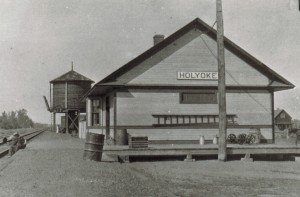 My dad’s family spent quite a few years living in the small town of Holyoke, Minnesota. The area is wooded and very beautiful, with the train tracks bordering the edge of town. As boys, my dad and my Uncle Bill were always fascinated by the trains. I think that is probably very normal for all boys, and especially this living in a small town. The trains become the highlight of the day. My husband, Bob loved to go out and count the cars on the train when
My dad’s family spent quite a few years living in the small town of Holyoke, Minnesota. The area is wooded and very beautiful, with the train tracks bordering the edge of town. As boys, my dad and my Uncle Bill were always fascinated by the trains. I think that is probably very normal for all boys, and especially this living in a small town. The trains become the highlight of the day. My husband, Bob loved to go out and count the cars on the train when 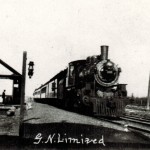 his family was living in the small town of Point of Rocks, Wyoming. I’m sure Dad and Uncle Bill did the same thing.
his family was living in the small town of Point of Rocks, Wyoming. I’m sure Dad and Uncle Bill did the same thing.
They knew the trains like a lot of guys know cars. Uncle Bill tells us in his family history that the first train is an early 1900’s 1500 Series Locomotive, and the second one is a 1910 1200 Series Locomotive that was used on passenger trains. I can imagine that they spent as much time talking to the employees of the railway as they did looking at the trains. Their curiosity was peeked and they wanted to know everything about those trains. Their dad worked for the Great Northern Railway too, so they were allowed to ride the trains to get to and from school…so any stories about how they walked 10 miles, in the snow, and it was uphill both ways, are 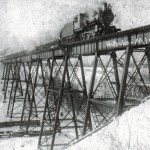 probably a little bit of a stretch.
probably a little bit of a stretch.
Uncle Bill actually got a job with the railroad one time but he didn’t keep it very long. He thought it was pretty boring work, and since I have had a few boring jobs myself, I can empathize with his thoughts on the matter. Maybe, if he had been doing work that was similar to what his dad did, he would have liked it better. While railroad work was not what they wanted to do, that did not dim their interest in the trains, but then, what else was there for two young boys to do in the small town of Holyoke, Minnesota. I never thought of them as small town boys, but maybe they were.
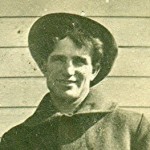 Before my Grandpa Spencer passed away from cancer, on October 19, 1951, his life had held some difficult, sad, and lonely moments. My Uncle Bill writes that his suffering, from the pain that comes with cancer, “increased steadily for the last year and a half…then it was over”, and no matter what mistakes he had made in his life, all that was left was sadness that it was over…longing for a few more days to settle matters…to find peace with what was coming. My Uncle Bill took care of him in those last years, and while there were some hard feelings between them in earlier years, in the end, Uncle Bill was very sorry that he was gone…I know that by the way he talked about his dad and his death. Grandpa wasn’t always the easiest person to be around, but in the later years, he and Uncle Bill had made a way…a careful relationship, I suppose, but it was a relationship at least, and for some years, there wasn’t even that.
Before my Grandpa Spencer passed away from cancer, on October 19, 1951, his life had held some difficult, sad, and lonely moments. My Uncle Bill writes that his suffering, from the pain that comes with cancer, “increased steadily for the last year and a half…then it was over”, and no matter what mistakes he had made in his life, all that was left was sadness that it was over…longing for a few more days to settle matters…to find peace with what was coming. My Uncle Bill took care of him in those last years, and while there were some hard feelings between them in earlier years, in the end, Uncle Bill was very sorry that he was gone…I know that by the way he talked about his dad and his death. Grandpa wasn’t always the easiest person to be around, but in the later years, he and Uncle Bill had made a way…a careful relationship, I suppose, but it was a relationship at least, and for some years, there wasn’t even that.
Don’t get me wrong, Uncle Bill loved his dad, but he didn’t always agree with everything his dad said or did…but then, what kid does. Grandpa was a man of the times. In those days you didn’t think twice about giving your kid a good spanking if they needed it, and in fact, you didn’t have an issue with taking someone else’s child to task if they got out of line. That said, you also didn’t pick on someone else’s kid either. One time Uncle Bill had been sent to town to get some money from his dad who worked on the railroad and lived in town during the week. Grandpa decided to buy him a sarsaparilla in the bar…which was ok at that time…and while there, another man began picking on my Uncle Bill. Well, his dad, my grandpa, told the man to leave his son alone, and when he would not, a fight ensued, and grandpa beat him up. Uncle Bill always felt like that was a very special event in his life. He was pleased that his dad had stood up for him in that way. Nevertheless, a few years later, there was some discord between the two men. Theirs was a guarded relationship for a long time, but in the end, they had started to work out their differences, and then time ran out.
Sometimes, when you read through the journals of another person, or in this case, the family history written by a man who dedicated his life to telling the family story as clearly 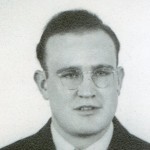 as he understood it, you find yourself taking a look deep into the reality of human relationships. No matter how annoyed we can be at someone, we can also love them very much. And when it comes to the point of their passing, those difficult relationships can leave a very different kind of hole in our lives…one filled with “what if’s” and “if only’s”, and once that person is gone, no way to change the relationship for the better or at least, forgive that past. Those who are left behind, must deal with their own feelings within themselves, because there is really no one there to talk to about it all. Nevertheless, I believe that Grandpa knew that his son loved him and I believe he loved Uncle Bill and his other children very much, too.
as he understood it, you find yourself taking a look deep into the reality of human relationships. No matter how annoyed we can be at someone, we can also love them very much. And when it comes to the point of their passing, those difficult relationships can leave a very different kind of hole in our lives…one filled with “what if’s” and “if only’s”, and once that person is gone, no way to change the relationship for the better or at least, forgive that past. Those who are left behind, must deal with their own feelings within themselves, because there is really no one there to talk to about it all. Nevertheless, I believe that Grandpa knew that his son loved him and I believe he loved Uncle Bill and his other children very much, too.
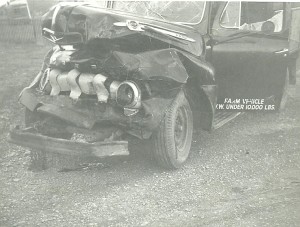 As a young family, my in-laws lived in Montana, and my father-in-law worked for the railroad. Their family was growing, and now they had 3 children, Marlyce, Debbe, and my future husband, Bob. My father-in-law was working for the railroad, and the family was living on railroad property.Things were going well enough, but in 1956, the decision was made to move the family from Dalin, Montana to Martinsville, Montana…neither of which still exist today, as near as I can tell, so unfortunately, I can’t say how long the trip was. That doesn’t really matter, because, any trip with three children under the age of 7 years, had to seem like an eternity. Nevertheless, this trip was about to get a little bit longer. They loaded their belongings into a 1951 Ford pickup truck, which was the first vehicle my father-in-law had ever owned, and it had been purchased brand new in 1951, so it was a nice vehicle. Everything loaded, they set out for Martinsville.
As a young family, my in-laws lived in Montana, and my father-in-law worked for the railroad. Their family was growing, and now they had 3 children, Marlyce, Debbe, and my future husband, Bob. My father-in-law was working for the railroad, and the family was living on railroad property.Things were going well enough, but in 1956, the decision was made to move the family from Dalin, Montana to Martinsville, Montana…neither of which still exist today, as near as I can tell, so unfortunately, I can’t say how long the trip was. That doesn’t really matter, because, any trip with three children under the age of 7 years, had to seem like an eternity. Nevertheless, this trip was about to get a little bit longer. They loaded their belongings into a 1951 Ford pickup truck, which was the first vehicle my father-in-law had ever owned, and it had been purchased brand new in 1951, so it was a nice vehicle. Everything loaded, they set out for Martinsville.
Along the way to Martinsville, a pickup pulled out in front of the 1951 Ford. The accident destroyed all their furniture and totaled the pickup. I can only imagine how awful that was. In those days, seat belts and car seats were unheard of, so I’m sure my in-laws thought they were all about to die. It was a devastating event, but the family was all ok, but, now they were stuck waiting for the police and tow truck, and had to figure out what to do next. The trip took just about the worst possible turn. I can hear the kids now. The girls were most likely crying because they were cold or hungry, and Bob being only 2 years old was either scared, or more likely curious…if I know him. It would be my guess that both of my in-laws had a massive headache from the trauma and worry, both for their family and for their future.

In the end, things turned out ok. The insurance money was enough to buy a 1953 Ford pickup and a 33 foot mobile home. I can’t imagine three kids in a 33 foot mobile home, but I’m sure they felt like it was practically a palace, considering the way things could have gone. Car accidents can conpletely devistate lives, but their little family was alive, and no one was hurt badly, so the rest of it was just stuff. If you can walk away from an accident like that in one piece, you thank the Lord, and count your many blessings.

